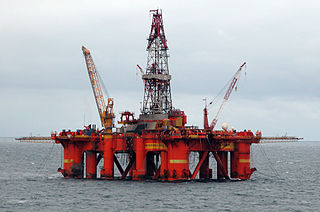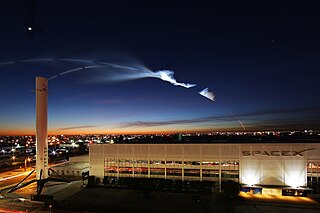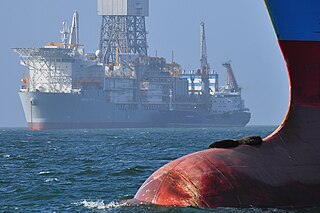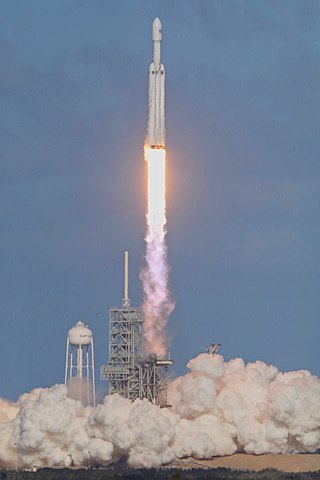
A semi-submersible platform is a specialised marine vessel used in offshore roles including as offshore drilling rigs, safety vessels, oil production platforms, and heavy lift cranes. They have good ship stability and seakeeping, better than drillships.

Space Exploration Technologies Corp. (SpaceX) is an American spacecraft manufacturer, launcher, and a satellite communications corporation headquartered in Hawthorne, California. It was founded in 2002 by Elon Musk with the stated goal of reducing space transportation costs to enable the colonization of Mars. The company manufactures the Falcon 9, Falcon Heavy, and Starship launch vehicles, several rocket engines, Cargo Dragon and Crew Dragon spacecraft, and Starlink communications satellites.

Valaris plc is an offshore drilling contractor headquartered in Houston, Texas, and incorporated in the UK. It is the largest offshore drilling and well drilling company in the world, and owns 56 rigs, including 40 offshore jackup rigs, 11 drillships, and 5 semi-submersible platform drilling rigs.

SpaceX is privately funding the development of orbital launch systems that can be reused many times, in a manner similar to the reusability of aircraft. SpaceX has been developing the technologies over several years to facilitate full and rapid reusability of space launch vehicles. The project's long-term objectives include returning a launch vehicle first stage to the launch site in minutes and to return a second stage to the launch pad following orbital realignment with the launch site and atmospheric reentry in up to 24 hours. SpaceX's long term goal would have been reusability of both stages of their orbital launch vehicle, and the first stage would be designed to allow reuse a few hours after return. Development of reusable second stages for Falcon 9 was later abandoned in favor of the development of Starship, however, SpaceX has been developing reusable payload fairings for the Falcon 9.

Starbase is a spaceport, production, and development facility for Starship rockets, located at Boca Chica, Texas, United States. It is in construction in the late 2010s and 2020s by SpaceX, an American aerospace manufacturer.
The SpaceX Mars program is a set of projects through which the aerospace company SpaceX hopes to facilitate the colonization of Mars. The company claims that this is necessary for the long-term survival of the human species and that its Mars program, including the ongoing development of the SpaceX Starship, will reduce space transportation costs, thereby making travel to Mars a more realistic possibility.

As of 2023, SpaceX operates four launch facilities: Cape Canaveral Space Launch Complex 40 (SLC-40), Vandenberg Space Force Base Space Launch Complex 4E (SLC-4E), Kennedy Space Center Launch Complex 39A (LC-39A), and Brownsville South Texas Launch Site. Space Launch Complex 40 was damaged in the AMOS-6 accident in September 2016 and repair work was completed by December 2017. SpaceX believes that they can optimize their launch operations, and reduce launch costs, by dividing their launch missions amongst these four launch facilities: LC-39A for NASA launches, SLC-40 for United States Space Force national security launches, SLC-4E for polar launches, and South Texas Launch Site for commercial launches.

SpaceX CRS-5, also known as SpX-5, was a Commercial Resupply Service mission to the International Space Station (ISS), conducted by SpaceX for NASA, and was launched on 10 January 2015 and ended on 11 February 2015. It was the seventh flight for SpaceX's uncrewed Dragon cargo spacecraft and the fifth SpaceX operational mission contracted to NASA under an ISS resupply services contract.

The Falcon 9 first-stage landing tests were a series of controlled-descent flight tests conducted by SpaceX between 2013 and 2016. Since 2017, the first stage of Falcon 9 missions has been routinely landed if the rocket performance allowed it, and if SpaceX chose to recover the stage.

An autonomous spaceport drone ship (ASDS) is an ocean-going vessel derived from a deck barge, outfitted with station-keeping engines and a large landing platform and is autonomously controlled when on station for a landing. Construction of such ships was commissioned by aerospace company SpaceX to allow recovery of launch vehicle first stages at sea for missions that do not carry enough fuel to return to the launch site after boosting spacecraft onto an orbital or interplanetary trajectory.

A super heavy-lift launch vehicle can lift a super heavy payload to low Earth orbit. A super heavy payload is more than 50 metric tons (110,000 lb) by United States (NASA) classification or 100 metric tons (220,000 lb) by Russian classification. It is the most capable launch vehicle classification by mass to orbit, exceeding that of the heavy-lift launch vehicle classification. Only thirteen such payloads were successfully launched prior to 2022: twelve as part of the Apollo program before 1972 and one Energia launch in 1987. Planned crewed lunar and interplanetary missions often depend on these launch vehicles' payload capacity.

Landing Zone 1 and Landing Zone 2, also known as LZ-1 and LZ-2 respectively, are landing facilities on Cape Canaveral Space Force Station for recovering components of SpaceX's VTVL reusable launch vehicles. LZ-1 and LZ-2 were built on land leased in February 2015, on the site of the former Cape Canaveral Launch Complex 13. SpaceX built Landing Zone 2 at the facility to have a second landing pad, allowing two Falcon Heavy boosters to land simultaneously.

SpaceX Starship development began in 2012, when Elon Musk, CEO of American aerospace company SpaceX, first publicly described a high-level plan to build a reusable rocket system with substantially greater capabilities than the Falcon 9 and the Falcon Heavy. The rocket evolved through many design and name changes. On July 25, 2019, the Starhopper prototype performed the first successful flight at SpaceX Starbase near Boca Chica, Texas. The SN15 prototype rocket was the first full size test spacecraft to take off and land successfully, in May 2021.

Elon Musk's Tesla Roadster is an electric sports car that served as the dummy payload for the February 2018 Falcon Heavy test flight and became an artificial satellite of the Sun. A mannequin in a spacesuit, dubbed "Starman", occupies the driver's seat. The car and rocket are products of Tesla and SpaceX, respectively, both companies headed by Elon Musk. The 2010 Roadster is personally owned by and previously used by Musk for commuting to work. It is the first production car launched into space.

The Falcon Heavy test flight was the first attempt by SpaceX to launch a Falcon Heavy rocket on February 6, 2018, at 20:45 UTC. The successful test introduced the Falcon Heavy as the most powerful rocket in operation at the time, producing five million pounds-force (22 MN) of thrust and having more than twice the payload capacity of the next most powerful rocket, United Launch Alliance's Delta IV Heavy.
Starship is a fully reusable super heavy-lift launch vehicle under development by SpaceX. Standing 120 m (390 ft) tall and with more than twice the thrust of the Saturn V, it is designed to be the tallest and most powerful launch vehicle ever built, and the first capable of total reusability. Partially and fully expendable variants may also be developed.

Raptor is a family of full-flow staged-combustion-cycle rocket engines developed and manufactured by SpaceX for use on the SpaceX Starship. The engine is powered by cryogenic liquid methane and liquid oxygen ("methalox") compared to the RP-1 and liquid oxygen ("kerolox") combination used in SpaceX's prior Merlin and Kestrel rocket engines. The Raptor engine has triple the thrust of SpaceX's Merlin 1D engine that powers the Falcon 9 and Falcon Heavy launch vehicles.
A floating launch vehicle operations platform is a marine vessel used for launch or landing operations of an orbital launch vehicle by a launch service provider: putting satellites into orbit around Earth or another celestial body, or recovering first-stage boosters from orbital-class flights by making a propulsive landing on the platform.















